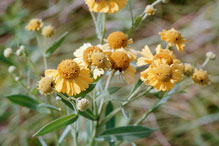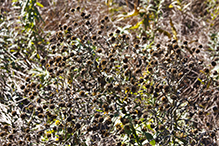Common sneezeweed
(Helenium autumnale)
Conservation • Wetland • Description • Habitat • Ecology • Use • Distribution • Taxonomy
Conservation Status |
|
||
| IUCN Red List | not listed |
||
| NatureServe | N5 - Secure SNR - Unranked |
||
| Minnesota | not listed |
||
Wetland Indicator Status |
|
||
| Great Plains | FACW - Facultative wetland |
||
| Midwest | FACW - Facultative wetland |
||
| Northcentral & Northeast | FACW - Facultative wetland |
||
Description |
Common sneezeweed is a 24″ to 60″ tall, erect, perennial forb that rises usually in a single stem, sometimes on 2 to 7 stems, from a shallow, fibrous root system. The stems are erect or ascending, winged, and branched above the middle. Above the middle the stems are moderately to densely covered with short, spreading to ascending, somewhat curled hairs. They are also moderately covered with yellow, stalkless or impressed glands. Below the middle the stem is sparsely to moderately hairy. Stem leaves are alternate, stalkless, numerous, and spread outward. The leaves are longest at the middle of the stem, becoming slightly smaller as they ascend the stem. The upper and lower surfaces are sometimes hairless but are usually moderately to densely covered with short, mostly spreading, sometimes curved hairs. They are also densely dotted with yellow, stalkless or impressed glands. Middle and upper stem leaves are 1½″ to 6″ long, and 3 ⁄16″ to 2″ wide. Basal and lower leaves are somewhat smaller than middle stem leaves. Basal leaves are lance-shaped, inversely lance-shaped, or inversely egg-shaped, and are sometimes cut with shallow, rounded lobes (pinnatifid). Lower and middle stem leaves are inversely egg-shaped to inversely lance-shaped. They are tapered at the base and angled or taper to a sharp point at the tip. The base of the leaf blade continues down the stem as a narrow, green wing. The margins are either untoothed or are toothed often only above the middle of the blade. Upper stem leaves are inversely lance-shaped to lance-shaped but otherwise similar to middle stem leaves. Basal and lower stem leaves are absent or withered by flowering time. The inflorescence is 2 to 25 flower heads in open, leafy, branched, panicle-like clusters at the end of the stems and branches. Each cluster is on a ¾″ to 3″ long, sparsely to moderately hairy stalk. The whorl of 15 to 21 green bracts at the base of the flower head (involucre) is globe-shaped, 5 ⁄16″ to ⅝″ long, and ⅜″ to ⅝″ in diameter. The bracts of the involucre (phyllaries) are in 2 series. The outer phyllaries are fused at the base. Each flower head is 1″ to 2½″ in diameter. There are 8 to 21 ray florets and 200 to 400 or more disk florets. The ray florets are yellow, ⅜″ to 1″ long, ⅛″ to ⅜″ wide, and double notched at the tip. They are narrow at the base and taper evenly to a broad tip. The disk florets are yellow and form a large, globe-shaped, sometimes somewhat flattened disk. The fruit is a dry, one-seeded, 1 ⁄16″ long seed capsule (cypsela) with a tuft of 5 to 7 short bristles (pappus) attached to the end. |
Height |
24″ to 60″ |
Flower Color |
Yellow ray florets, yellow disk florets |
Similar Species |
Purple-head sneezeweed (Helenium flexuosum) leaves are mostly erect. Disk florets are purple or brownish-purple. The plant has been recorded only in Carlton County. |
Habitat |
Moist to wet. Forests, prairies, fens, marshes, river banks, streambanks, roadsides, railroads, disturbed sties. Full sun. |
Ecology |
Flowering |
August to October |
Pests and Diseases |
|
Use |
|
Distribution |
||
|
Sources Biodiversity occurrence data published by: Minnesota Biodiversity Atlas (accessed through the Minnesota Biodiversity Atlas Portal, bellatlas.umn.edu, 8/20/2025). |
|
| 8/20/2025 | ||
Nativity |
||
Native |
||
Occurrence |
||
Common |
||
Taxonomy |
|
Kingdom |
|
Subkingdom |
Pteridobiotina |
Phylum |
Tracheophyta (Vascular Plants) |
Class |
|
Order |
Asterales (Sunflowers, Bellflowers, Fanflowers, and Allies) |
Family |
Asteraceae (Sunflowers, Daisies, Asters, and Allies) |
Subfamily |
Asteroideae |
Tribe |
Helenieae |
Subtribe |
Gaillardiinae |
Genus |
Helenium (sneezeweeds) |
Section |
Helenium |
Subordinate Taxa |
|
Several varieties of Helenium autumnale have been described. Three are recognized by USDA PLANTS. Of these, only the nominate variety, Helenium autumnale var. autumnale, occurs in Minnesota. Most sources either accept the varieties as questionable or do not accept them at all. |
|
Synonyms |
|
Helenium autumnale var. autumnale Helenium autumnale var. canaliculatum Helenium autumnale var. fylesii Helenium autumnale var. grandiflorum Helenium autumnale var. montanum Helenium autumnale var. parviflorum Helenium canaliculatum Helenium latifolium Helenium macranthum Helenium montanum Helenium parviflorum |
|
Common Names |
|
autumn sneezeweed bitterweed common sneezeweed fall sneezeweed smooth oxeye mountain sneezeweed sneezeweed |
|
Glossary
Cypsela
A dry, one-chambered, single-seeded fruit, formed from a single carpel, with the seed attached to the membranous outer layer (wall) only by the seed stalk; the wall, formed from the wall of the inferior ovary and also from other tissues derived from the receptacle or hypanthium, does not split open at maturity, but relies on decay or predation to release the contents.
Involucre
A whorl of bracts beneath or surrounding a flower, flower head, or flower cluster.
Panicle
A pyramidal inflorescence with a main stem and branches. Flowers on the lower, longer branches mature earlier than those on the shorter, upper ones.
Phyllary
An individual bract within the involucre of a plant in the Asteraceae family.
Pinnatifid
Deeply cut, more than half way to the midrib but not to the midrib, into lobes that are spaced out along the midrib; the lobes do not form separate leaflets.
Wing
A thin, flat, membranous, usually transparent appendage on the margin of a structure.
Visitor Photos |
Share your photo of this plant. |
||
This button not working for you? |
||
Luciearl |
||
Sneezeweed |
||
 |
 |
|
 |
 |
|
Delighted to find bumblebee love this plant. Growing in shoreline buffer. |
||
 |
 |
|
MinnesotaSeasons.com Photos |
 |
 |
|
Plant |
Plant |
|
 |
 |
|
Plant |
Plant |
|
 |
 |
|
Inflorescence |
Inflorescence |
|
 |
 |
|
Inflorescence |
Flower head |
|
 |

|
|
Leaves |
||
|
||
|
||
|
Winged stem |
|
 |
 |
|
Infructescence |
||
|
||
|
||
|
Infructescence |

Slideshows |
|

Visitor Videos |
Share your video of this plant. |
||
This button not working for you? |
||
|
Other Videos |
Sneezeweed - Helenium autumnale |
About
Published on Aug 24, 2012 Earthyman views Sneezeweed (Helenium autumnale) at Ion Exchange native seed and plant nursery in NE Iowa. Sneezeweed is a wetland wildflower http://ionxchange.com/products/HELENIUM-AUTUMNALE-%7C-Sneezeweed.html |

Visitor Sightings |
Report a sighting of this plant. |
||
This button not working for you? |
||
Luciearl |
Location: Lake Shore, MN |
 |
| Luciearl 9/3/2020 |
Location: Cass County Delighted to find bumblebee love this plant. Growing in shoreline buffer. |
 |
MinnesotaSeasons.com Sightings |

Created: 8/27/2004 Last Updated: © MinnesotaSeasons.com. All rights reserved. |
